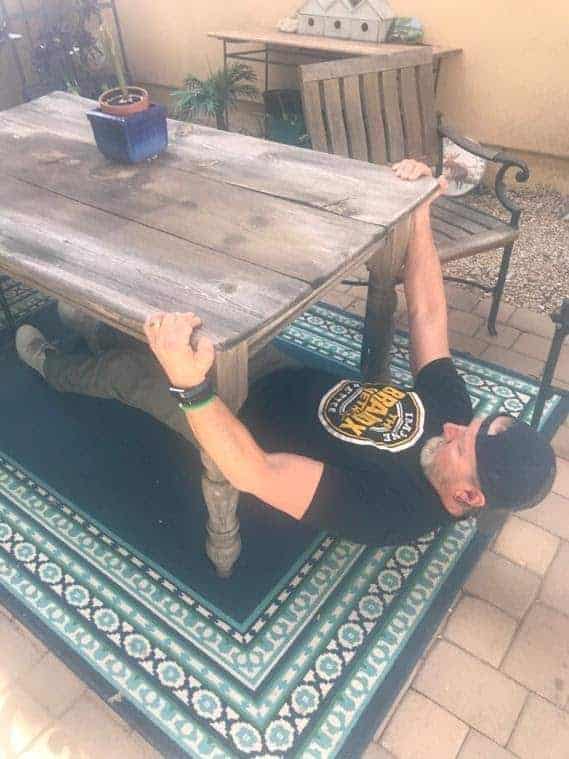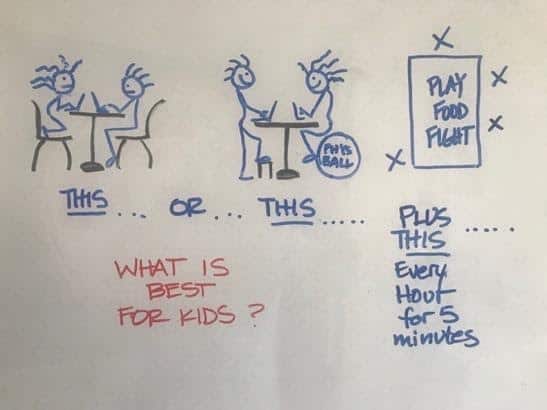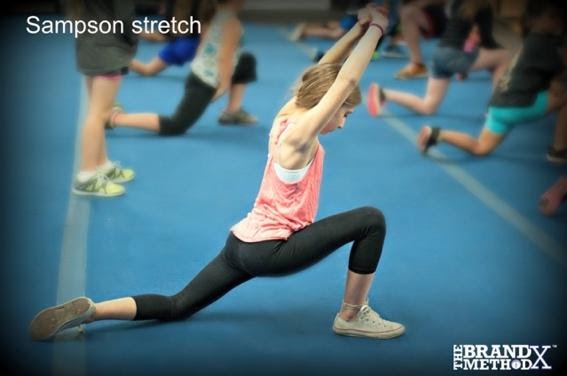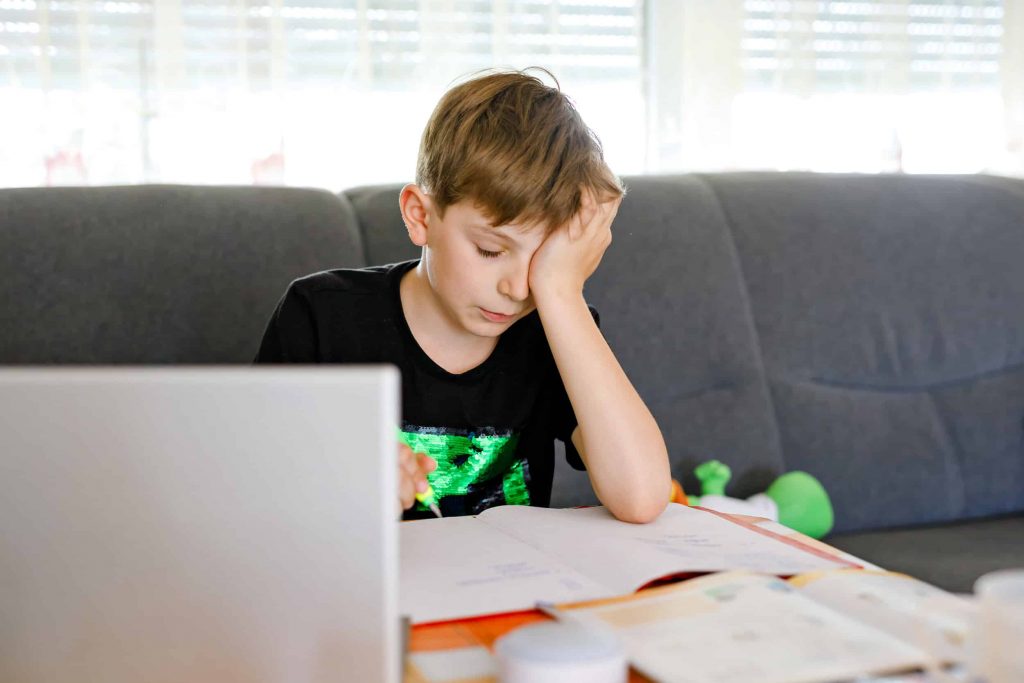Simple Ways To Keep Your Kids Moving During COVID-19
“This is the best Spring Break we’ve ever had, because we are all together.”
-Lily age 10
There are some great moments.
“You’re teaching it wrong mom”
-Evan age 6
There are some tough moments.
Many of us are alternately enjoying and being frustrated by this new level of togetherness.
This new normal presents not only problems that we are not used to dealing with but chances to rethink how we interact and what we prioritize.
Keeping our sanity, our mental health intact, and supporting our kids’ mental health through this challenging time also means we must, must, must keep them moving, playing, and interacting socially (within personal distance guidelines, of course).
We can create new opportunities to move and play more often and together.
While many of you have got this and many kids move without encouragement (we see it daily on sidewalks and in parks, on bike trails and streets), we also know many of you are struggling to find easy and fun ways to keep your kids engaged and excited about moving throughout the day.
At The Brand X Method, we have been working for years to teach kids and their coaches how to move well (what we call physical literacy) and play hard and our method has always been designed to work in austere environments with very little (or no) equipment, like your home. Given that most of us are stuck at home and many kids are stuck on tech, the Starrett’s invited us to share some of our favorite ideas to help keep your kids moving during this time. Here goes:
Adding Movement to Home Study Lessons
Movement does not always have to be a formal practice like doing a workout or playing a sport. There are many ways to incorporate movement into your child’s home school day while they are studying and, believe us, these little movements add up.
English/Literature:
- Read-Walking – Have kids try walking around while reading, movement increases the potential for better retention.
- Earn Your Breaks – Breaks of up to 15 minutes can be given for anyone who does 10 slow squats and then immediately offers a vocabulary word no one else can correctly define within two minutes and without the help of any device.
Geography:
- Draw your country outline in chalk in the street.
- Locate and perform 5 squats on a state/province/territory that starts with A, tuck jump on those that start with B, etc.
- Plank on the state with the tallest mountain, mountain climbers on the most populated areas – you get it, be creative!
Math:
- Older kids– Look at the time throughout the day, if anyone stops/calls out the time when minutes can be divided by 5, do 1 minute in the bottom of the squat, any multiple of 5 grasshoppers, and 1 more minute in the bottom of the squat.
- Fractions – If your child has started to learn fractions, bear crawl a large circle and side shuffle to divide it into designated fractions.
Science:
- Drink X ounces of water every hour – do some internet searches together on the right amount of hydration in differing environments.
- Challenge young kids to only move like a chosen animal for a portion of the day. (i.e. Bunny Hop from 8-9, crawl like an alligator from 11:30-12:00). Ask older kids to maintain this for longer, use only bear crawls to get around until lunchtime. Sounds silly, but its really fun.
- Play the nutrition game, where you explain and teach simplified basic macronutrients – meat and fish are protein, nuts are fats, fruits, and veggies carbs – at the level child can understand. Then create landmarks and associated exercises that pair with each. For example, if you call out a protein, they do 3 pushups next to the couch; if you call out a fat they do 6 burpees near the fridge; if you say a carb they do 10 squats near the front door.
General Movement during Study:
Flashcards – 1 burpee for correct answers. 3 burpees for incorrect answers, 2 for mom and dad.
Baskets: Get up, 10 jumping jacks, 10 mountain climbers, Free throw to any improvised basket every 10 minutes.
Trampoline: If you are lucky enough to have a trampoline, add trampoline breaks every two hours for 15 minutes.
Pick a movement each day that you stop and do every hour, or at every commercial if watching TV. (Like 10 frog hops or 10 push-ups).
Pick a movement that you will increase by 5 reps each day until you reach a target number, then do that number each day for 5 days. Start over with a new movement.
Challenge a family member to a static hold contest. This could be a position you are practicing- Hollow Hold, T Plank, or Bottom of the squat.
This can be an ongoing challenge requiring everyone to freeze and hold a position for the max time at unexpected times of the day, with each family member alternating days to be the one to call Freeze. Anyone sitting or lying down when Freeze is called gets assigned a random balance position instead.
Pick up socks with bare feet and hop around a few times a day. Notice how much better you get at grabbing with your feet with practice.
Look up and learn a new stretch or mobilization every day. The Ready State, of course, has a lot of good ones.
Practice balancing by doing airplanes, frog stands, and pendulums.
Climb trees (with an adult to supervise).
Pillow fights are fun breaks, handicap bigger people with smaller pillows, and single-leg hops. You can also play pillow smash where you earn 10 pillow smashes into the ground or to knock something over (like a cone) for every 10 jumping jacks.
Common Household Items That Can Be Uses as Exercise Props
Laundry baskets can be used to push or pull like prowlers, fill them with light to heavy loads, use books or smaller siblings for heavier versions. Kids 10 and over can usually also use them for lateral jumps.
Tile provides great landmarks for broad jumps, shuttle runs, side to side hops (or for a game of Jumpy Checkers, see description below).
Couch cushions can be stacked and used as hurdles, ottomans work well too
Countertops are great for elevated pushups – like this:

Get under the edge of a sturdy/heavy table for pull-ups, or throw two knotted towels over a door (close it with knots to the outside).
Positions, Strengthening and Movement Break Games
With all of the seated online classwork, our kids are going to need breaks to move, open their hips, and reset the head and neck positions.
Opt for standing with a footstool, using a physioball or barstool, allow for lots of changing positions throughout desk/table/study time.
Additionally, you can have planned breaks to move or play every hour or so. (Food fight is a popular and easy game to stage, see below).

Consider having kids do a hip opening stretch, 2 minutes each side every hour.

Bottom of the Squat Dance Party, multiple kids
Using music, have kids line up shoulder to shoulder in the bottom of the squat, ask one child at a time to lead the dance party, where for 30 seconds the leader will dance in the bottom of the squat position and everyone else will mirror the leader’s movement.
Bottom of the Squat Dance Party, Parent, and Child
Using music, face each other, and go to a relaxed bottom of the squat position, take turns to create and mirror a dance using the upper body while keeping the bottom half in the bottom of the squat position. Test 30 seconds to a minute to alternate dancers.
Balance and head neck position
Practice walking with a big relatively heavy book on your head, concentrate on neutral head position, look in the mirror to position your head and neck so that your profile is in alignment and not “head forward” before starting.
Add difficulty by trying walking lunges with the book.
Stinky Feets and Hops
Why not use this time stuck at home to work on making our feet stronger to support all of the up chain moving parts we use in sport and play? (ankles, knees, hips). One of the ways we do this is with the Stinky Feets Game that has many variations. Practice shoeless single leg hops 10 each leg every time the ice maker makes noise in your kitchen, or a truck back up sound goes off in your neighborhood, you hear a lawnmower, dogs barking, etc.
Stinky Feets Game- multiple players
With a central bucket, scatter at least two socks per child around the playing floor. Upon go- shoeless players begin from any point in a circle about 5m away from the central bucket and hop on one leg to grab socks with the non-hopping foot to retrieve and deliver socks to the bucket by using only one-legged hops. Legs and feet (hopping or grabbing) may be switched only at the bucket.
Alternately, play can also be arranged as team races, to separate buckets using one sock per team.
Stinky Feets Drill
For 3-5 minutes, shoeless grab a sock with one foot, and throw it to catch with either hand. See if you can throw the sock to a family member to catch and throw it back.
Stinky Feets Solo
Place two socks 6 feet apart. Start at one side by grabbing a sock hop to the other side put the sock down, switch feet pick up the second sock and hop back to start, then bear crawl 6 feet in both directions and repeat.
Jumpy Checkers
This game as all about jumping, landing, and passing and you need at least four players. Parents throw in as needed! This game is all about practicing and reinforcing good foot, ankle, and knee positions while jumping and landing within a game. Set up by creating a contiguous playing area with 2’x2’ chalk squares or use existing tile, 4 squares per child, or 3×3 for bigger kids or teens.
Arranged as close to a square as possible as in the example above. A 6×6 field will work best. There should be constant motion–players should be told they are jumping landing or freezing in position, but only standing for a split second. Review “Waiting in the Outfield,” jumping initiation and landing positions. Practice single jumps. Two teams are created. Each begins with a dodgeball. Nerf balls may be used in place of dodgeballs (only super softballs may be used due to throwing proximity to other players).
Teams start on opposite ends (like checkers). The goal is to pass a dodgeball to teammates to move it to the opposite side. The ball may be passed only after a player jumps. The ball carrier can take only one or two jumps then must pass.
Jumps are to be executed from a good “Waiting in the Outfield” hinge position at the start and at the end. Jumps can also be in any direction but must be n a straight line, no diagonals. Non-ball-carrying players must jump-land one square at a time and attempt to block the progress of opposing teams ball carrier while staying ready for a pass. All players including the ball carrier must get to the opposite side before the opposing team gets to theirs. Only one person may occupy a square at any one time.
Complexity may be added for older or experienced groups by stacking bumper plates within a few of the squares, if available. Jumps would still require points of performance but onto an elevated surface. The parent may call freeze to have all players get “organized” in either a static jump initiation or landing position (no other positions allowed) at any time.
Food Fight
Food Fight is a game played with soft objects around a 6’x12’ “virtual table” on the floor made of rope, chalk lines, broomsticks, grout lines in your tile, or PVC. “Seats” at the table are one or two per side, represented by the x’s above.
“Food” can be anything super soft, zipper-less small pillows, bean bags, plastic-wrapped paper towel balls, pairs of rolled-up socks, etc.- about 15-20 pieces is a good place to start. Starting from a “seat” upon “Go” players complete a given exercise (i.e.10 jumping jacks, reverse lunges, squats) and then can throw “food”.
- Food must cross over the table (cannot be thrown directly at a player without crossing the table).
- Players may not stand on the table.
- Play stops once all food has been thrown.
- Reset the table, choose a second exercise and repeat
Brand X® Resources
- 3 months worth of At Home Bodyweight No/Low equipment programming for both Kids and Teens contact: [email protected]
- Free Zoom Movement class for kids ages 4-10 Fridays, 9 a.m. Pacific – For link Contact: [email protected]
- For Youth 10-18, we have launched The Teen Fitness League, which provides a weekly competition, At Home Series is bodyweight only. https://competitioncorner.net/ff/online/3799/results
- Find us on IG https://www.instagram.com/thebrandxmethod/
- Check out our extensive Brand X ® Youth Training Education Online https://thebrandxmethod.com/certification-courses/
Recommended Resources for Kids and Parents
PE and home activity: https://openphysed.org/activeschools/activehome
Play and projects: https://www.thegeniusofplay.org/
Tweens resource: https://michellemitchell.org/
Mental Health/ Anxiety: https://summit.sfu.ca/system/files/iritems1/19975/RQ-14-20-Spring.pdf



















TRS Virtual Mobility Coach
Guided mobilization videos customized for your body and lifestyle.
FREE 7-Day Trial